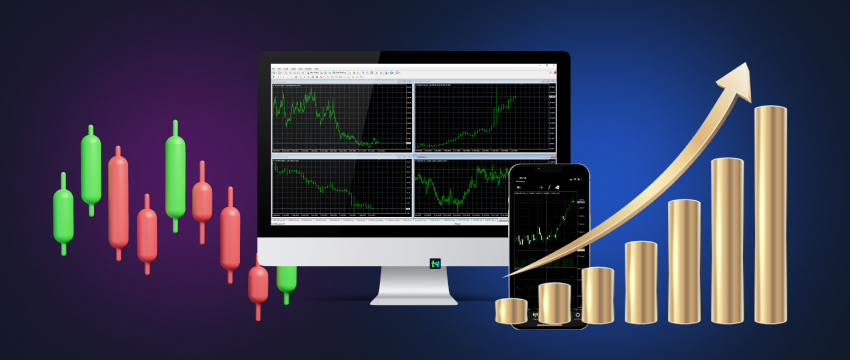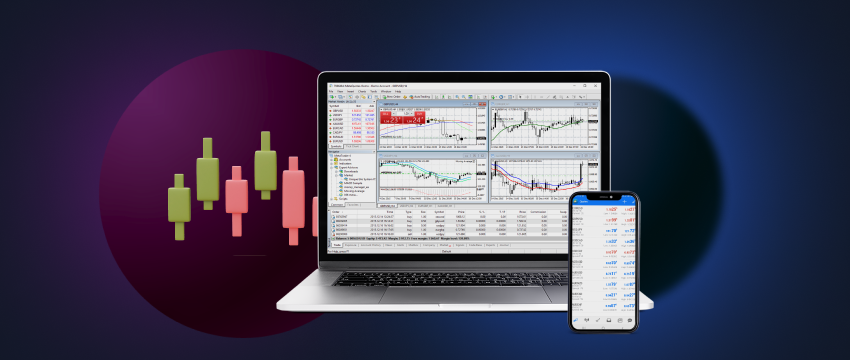In this article, we’ll be exploring indices. We’ll be looking at what they are and how they’re used. We’ll also be tackling how indices are traded online, including trading CFDs on indices.

Understanding indices
You’ll have likely heard of the terms indices or indexes used interchangeably. Indices typically refer to the plural form of an index.
A stock market index is created by choosing stocks of similar companies or those that meet specific criteria. Indices, commonly referred to as stock indices or share indices, are used to measure how a group of assets (e.g., stocks, securities) performs.
What is indices trading?
Indices trading is the act of trading CFDs on a particular stock market index. An index indicates how a group of stocks is performing. If the price of a group of stocks goes up, so too does the value of the index. Alternatively, if the price drops, so too will the value of the index.
How to trade indices
One of the most popular ways to trade indices is by trading CFDs (Contracts for Difference) on spot indices. CFDs enable you to potentially profit from falling or rising prices. Online indices trading on CFDs involves speculating on the price movements of indices instead of owning the actual asset.
For example, if you speculate that the index price will fall, you can open a short (sell) position. If, however you believe that the index price will go up, you can open a long (buy) position.

A quick look at US stock market indices
Three of the most popular stock market indices in the US include the Dow Jones Industrial Average (DJIA), Nasdaq Composite and S&P 500. In addition, there is also the Wilshire 5000 which includes stocks from the entire US stock market. Stock market indices provide a way for investors to make informed decisions.
Dow Jones Industrial Average
One of the oldest and most frequently used indices, DJIA is a price-weighted index and includes stocks of 30 of the US’s largest and most powerful corporations. It also represents approximately ¼ of the value of the entire stock market in the country. DIJA monitors the overall performance of these 30 companies.
Nasdaq Composite
An index with over 3,700 stocks listed on the Nasdaq exchange. It is a capitalisation-weighted index. The Nasdaq Composite covers more companies from a larger range of industries than DJIA does, with the technology sector making up a large percentage of the overall composition of the index.
S&P 500
Like the Nasdaq Composite, the S&P 500 is a capitalisation-weighted index of large-cap stocks. The S&P 500 represents a number of different industries and sectors which is why this index is sometimes regarded as being more volatile than the DJIA. This means that when the market does well, its gains could be higher whereas when the market falls, losses could be steeper.
Other types of global stock indices
Regional stock indices
Regional stock indices represent specific geographic regions. An example is the FTSE Developed Asia Pacific Index which tracks the performance of stocks listed in developed countries within Asia.
Sector-based indices
Sector-based indices track specific sectors of the stock market such as healthcare stocks or financial stocks.
How is an index built?
Indexes are constructed in different ways, with the 3 most common including:
A market value-weighted index
Also known as a capitalisation-weighted index, it puts additional weight on the components that have the biggest market value, e.g., the S&P 500. In other words, the index components with higher market caps will be weighted more in the index.
A price-weighted index
More weight is added to the most highly-priced components, e.g., the Dow Jones Industrial Average). The stock of each company is weighted by its price per share. The index is the average of all the company’s share prices.
An equal-weighted index
Sometimes called an unweighted index. Here, each component is assigned the same weight. What this means is that each stock in an index is given the same importance or equal statistical importance, regardless of the size of a company.

What drives index prices?
When stock prices in an index rise, so too do the index. However, if stock prices plummet, the index falls too.
Stock price fluctuations are driven by various factors including:
- Taxas de juros
- Inflação
- Geopolitical events and/or political instability
- Economic news
- Sentimento dos investidores
- Company mergers/acquisitions
- Natural disasters
- Supply and demand for stocks
Benefits of trading indices
There are several benefits that index trading offers. For one, it is a common way to gain exposure to financial markets without the need for investing directly in individual company stocks, commodities, or other assets.
Other benefits include:
A lower margin requirement
The initial margin requirement for indices trading is low and leverage can be high. Further, with CFDs on indices, you can take advantage of upward or downward movements in the price of an index.
Diversification of portfolio
Speculating on the price of multiple stocks gives a trader greater exposure to the market. For instance, trading on the US_Tech100 index listed on the NASDAQ 100 gives you the opportunity to diversify across some of the world’s most powerful tech companies. What does this mean? Well, by trading in numerous companies through one single asset, if one or more companies fail, the index could still rise.
Unlike currencies, indices have more consistent trends
The market movements of indices are dependent on price fluctuations of the underlying stocks within the index. Stocks within the same sector typically trend in a common direction. Therefore, during bullish periods, indices will usually react accordingly and follow the same trend. This can potentially make them more predictable.
Selecting an indices trading platform
Trading platforms provide a convenient way to trade indices. Look for a broker that offers an innovative, reliable indices trading platform with quick access to technical and fundamental analysis, advanced security capabilities, automated trading, as well as features like graphs and charts.
Follow the steps below to start trading today:
- Open a demo ou live account
- Choose the index you want to trade
- Select your trading platform
- Open a position, monitor, and close your first trade.
AVISO LEGAL: Este material tem por objetivo apenas uma informação geral e educativa e não deverá ser considerado como aconselhamento ou recomendação ao investimento. O T4Trade não é responsável por quaisquer dados fornecidos por terceiros aqui mencionados, ou com links diretos, nesta comunicação.



